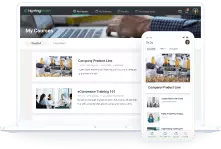Channel Partner Training: An Effective Tool for Growing Your Business

In this era of globalization, fewer and fewer companies are willing to settle for local markets. They dream of distributing their products and services throughout the country and even around the globe. This is precisely why companies are looking for partners that will help them win the world (or at least expand their market reach.)
Channel partner training becomes a must as soon as the first external partner joins your business and becomes even more important while their number and share in the company’s sales are growing.
In this article, we’ll discuss how to create an effective channel partner training program and utilize modern technologies to launch and manage it with ease.
What Is Channel Partner Training?
Partner training is the process of providing partners with the knowledge they need to promote, sell, and serve your products and ensure a high level of customer satisfaction and loyalty.
What are channel partners and why should you care about them?
Why can’t a company sell its products around the world on its own, scaling itself and opening new offices in every corner of the Earth? First, this requires lots of money, effort, and time to build such a chain. Second, partners help the vendor increase sales by reaching out to new groups of potential customers or offering terms and extra services that the vendor cannot provide on their own.
Why do some customers prefer to buy from partners and resellers, and not directly from a vendor?
- An extensive line of products. Imagine a supermarket – a desired partner for thousands of vendors. FMCG manufacturers generate customer traffic, allowing visitors to satisfy all their needs under one roof. Thus, when a customer needs soap, they go to the supermarket (not a soap factory), because there they are able to choose from among a variety of types of soap and pick up some other items as well, like a kilo of apples and a pair of socks.
- Communication and service with an orientation toward regional needs. Local partners know their markets better: customers’ habits and expectations, the specifics of legislation, and competitors’ regional strategies.
- Effective solutions to organizational issues. From shipping and warranty repair services to providing invoices, your channel partners can accomplish it all faster and more efficiently, as they are closer to your customers.
- Well-established relationships between a reseller and customers. Once a customer and a reseller have reached agreements for cooperation, signed a contract, and achieved a positive collaborative experience, there is no reason for a customer to undergo the same procedure with another supplier. For example, if you bought office PCs from an online retailer and were satisfied with the speed of delivery and services, you will probably come back again when you need a new printer.
The Benefits of Channel Partner Training
Now, we can see that partner sales can help greatly in scaling your business. But simply providing partners with your product and some advertising brochures is not enough to get deals flowing in. You need to equip your resellers with all the necessary knowledge and skills to conquer customers’ hearts and budgets.
Investing in a comprehensive partner enablement program will allow you to realize many benefits:
- Increased sales
If your partners know how to effectively promote, convincingly present, and sell your products easily, they achieve better results and bring you more revenue in a shorter period of time.
- Reputation risk management
The more information about your product and company your partners receive from you directly, the more likely it is that they will not misrepresent your brand but will communicate your values and vision correctly.
- Winning when competing with other vendors
As a rule, your partners sell not only your products but also those of your competitors, as well as goods in other categories. Your partners divide their resources (shelf space, co-marketing activities, and motivating programs for their sales reps) between all their suppliers. That means you need to compete with other vendors on this “internal market” for a partner’s attention and resources.
If you train your channel partners to sell your product effectively, you help them to increase sales and earn more with you. The larger the share of your partners’ total revenue that you command, the more opportunities they will see in collaboration with your brand. This eventually encourages them to invest more resources in promoting your products, and presto – your sales increase even more!

- Solid relationships with partners
A well-thought-out training program will be evidence that you are ready to invest time and effort to develop the partner network, meaning that you intend to establish long-term relationships.
This will help you increase revenue, build relationships based on mutual trust and advantage, and even reduce expenses (including the costs of solving problems that poorly trained partners can bring to you.) That’s why a training program for your channel partners turns out to be an investment that always pays for itself.
How to Create a Channel Partner Training Strategy
Now, it’s time to figure out how to create an effective channel training strategy that covers all important aspects your partners need to know.
Following these steps will bring you the desired results.
Step 1. Determine your goals
An objective like “All partners will successfully pass the final quiz and get certificates by the end of the month” will bring you nothing but mental satisfaction. If you prefer dollars, you need to set measurable objectives that are stated in concrete numbers.
For example, if your company aims to enter new regions, it will need to find and establish a number of new partners in these areas. And you’ll need to focus on your partner onboarding program in order to enable new resellers faster and keep them highly motivated. For this purpose, you can formulate your goal as “To speed up partner onboarding from 4 to 2 weeks” or “To increase new partner retention by 40%.”
In case your company wants to increase a share of a particular product on the market, you need to provide your partners with detailed product training and sharpen their skills in selling this product to customers and set a goal like “To increase partners’ sales of our product by 20%.”
Step 2. Define your audiences and their roles
Just like the staff in your company, your channel partners’ employees are not a homogeneous audience, as they perform different tasks and have different responsibilities.
Define departments in partner companies whose performance influences the results of your collaboration (e.g., sales volume, customer satisfaction rate, and repeat sales) and suggest a comprehensive training program for them.
Imagine that you need to create partner training programs for three businesses: a software vendor (selling its computers through distributors), a CRM provider (that aims to grow its business with value-added resellers), and a pizzeria growing its franchise network.
Below, you will find some ideas on how to build your channel partner training strategy.
| Partner type | Training audience | What to include |
| Distributor | Sales departments presenting and selling your goods to resellers |
|
| Value-added reseller (VAR) |
|
|
| Pizzeria franchises |
|
|
Step 3. Decide what knowledge each target group needs
Basically, there are two types of training programs: an onboarding training (helping the learner get into the nuts and bolts of the processes regardless of their job position) and specialized training (covering specific aspects depending on the employees’ roles and goals).
Let’s list basic topics to be covered in nearly any onboarding program.
- Company overview. Help your partners better understand what kind of organization you represent. Let them know about your history, key personalities, goals, and mission. This part is not supposed to be a detailed list of all events that occurred with your company since it was founded. Instead, tell them a short motivational story explaining the value you bring to the world and inspiring people to share your vision.
- Rules, standards, and expectations: what communication style is to be used to interact with company representatives and with customers, if there is a dress code in the company, and how partners can share their ideas and suggestions with the head office.
Provide your channel partners with information about your company’s structure and instructions on what departments they can contact if they have any questions.
- Product training: what is its key value, why do customers buy your product, what problem does your product solve, and who usually uses it? A detailed description of your product, its features, and benefits will help your partners to focus on the right audience and communicate with them more effectively.
We have already touched on the topic of partner product training – feel free to read it.
When it comes to specialized training programs, their content will depend on what departments or job positions you are addressing.
- Partner sales departments. Basically, these people are selling your product to clients all over the world, which means that you need to provide them with the same training for their sales reps as you supply your internal employees. Here are some topics to cover: how to present your product and its benefits, how to explain its value and differentiate from competing offerings, how to justify the price to customers and offer discounts.
Do some research to understand the level of professional skills that your partners’ sales teams possess (e.g., you can apply to a partner’s office as a mystery shopper to evaluate the level of services they offer). It might turn out that they need some basic sales training program that is not directly related to your product, such as how to convince prospects to buy or how to handle objections.
- Partner marketing teams. If you expect your partners to perform some promo activities for your product, you need to equip them with information about your target audience, results of the research you performed, and examples of effective marketing campaigns that you or other partners have executed. Include detailed instructions on how to use your brand identity elements and to what extent partners can use or change it.
- Production staff. This part of your channel partner training needs to be tailored to teach production workers to maintain the high level of your product and services (from baking your cinnamon cakes to installing your alarm systems).
- Partner management teams. You can help your channel partners reduce management risks and run their business safely. Include information in their training program on legal regulations and tax requirements, tips on how to build and motivate effective teams, and ways to optimize operating and administrative costs.
Step 4. Choose a training format that suits your audience
Now, it’s time to decide how you are going to deliver information to your trainees. You can opt for brick-and-mortar training rooms and trainers traveling from one partner to another, sending training materials via email, or move your training online (in the form of live webinars, learning materials for self-studying, or a mix of these.)
Depending on the trainees’ working process and conditions, some training approaches can be more desirable and comfortable than others.
Here are basic questions you need to find answers to:
- Where do they work? Do they work in offices equipped with PCs with headsets or do they work “in the fields” with only their smartphones available?
If your trainees work in the office
| Advantages | Disadvantages |
| All activities and communications need to be scheduled during working hours. |
If your trainees work in the field
| Advantages | Disadvantages |
|
|
- When will they take the training? Will they be allowed to pause their workflow for an hour or more to take part in your training activities or will they only have brief breaks between their regular work activities?
| Working hours dedicated to training | Short breaks between working tasks |
|
|
- How well equipped are they with the necessary devices and technical knowledge?
We tend to assume that others live and work in the same conditions that we do, but in fact, the level of a staff’s technical equipment, as well as their level of computer literacy can differ greatly in different countries and regions.
| Modern devices with stable internet connection and a tech-savvy staff | Limited technical options or skills |
| This gives you opportunities to apply any type of training: from classic slide-based courses to gamified training with virtual reality. |
|
Step 5. Find ways to motivate your channel partners
Keep in mind that partners are not employees and you can’t push them to take training. On the other hand, traditional motivational systems won’t work for them. To engage partners, you need to make them feel they are important and appreciated members of your team, and that your business respects their contribution to the common result.
Use training programs to eliminate the distance between your office and partners, telling them about objectives your company has and the results that your successful partners get. During general meetings (webinars or offline events), encourage members to share their experience and help each other find solutions.
Step 6. Make partners’ feedback your inspiration
The biggest mistake one can ever make when creating a channel training program is considering it as a one-off activity. You can never make your training time-saving, engaging, and efficient enough. There’s always a way to make it a bit better.
So, let the partners have a say in discussing the training programs. Ask them questions that will help you evaluate the program’s effectiveness and the degree to which it satisfies the partner’s training needs:
- Are learning materials clear and easy to understand?
- Do learners feel prepared to start working with your products and are they equipped with all the information they need?
- Did they get answers to all their questions? If not, do they know where they can find additional information?
- Are there any conflicts with the internal business process or regional situation in different countries?
Keep gathering input from your partners, involve them in the discussion of new programs and courses, and motivate them to share their ideas. This will help you stay on the same page with your trainees and understand their needs better. On the other hand, this close collaboration can become a good motivating factor and help you differentiate your brand from other vendors the partner deals with.
Partner Training Challenges
Equipped with a step-by-step channel partner training strategy, you probably feel that nothing can stop you from creating a compelling partner training program. But allow us to warn you of the difficulties you might face, so you can take some measures beforehand to avoid them.
- Ever-increasing training expenses. As your partner network expands, you’ll need to grow your training team and increase your training expenses сorrespondingly.
- Challenges in training small or distant partners. You will always choose to invest in training those partners whose increased sales performance will allow you to recoup your costs quickly. So partners that are smaller or distant (or both) will never get as much attention from your trainers as the big players will. This means they will have even less chance to succeed in this partnership.
- You can’t be sure that training materials are used effectively. There will always be a chance that a new presentation you emailed to your partners is slumbering peacefully in the spam or read-it-later folder forever. You also can’t guarantee that every new hire in the partner company will have access to the training materials.
- To keep partners privy to the latest updates, you’ll need to persuade them to train regularly. The partners’ new hires, your new products, and sales and promotions – you will always want to provide partners with new information, but they will obviously not interrupt their workflow each time you come up with a new training program.
How to Automate Channel Partner Training
You can handle most of these challenges easily by moving your training to the Web. This will make training materials available simultaneously for all your partners around the globe and allow you to create a structured database that is easy to manage and update.
If you add a learning management system (LMS) to this equation, you’ll be able to put most of the routine tasks on autopilot. An LMS is an online platform that allows you to assign training programs to trainees and track their progress.
The right LMS can perform most of these processes automatically:
- Any repetitive tasks. Routine course assignments, invitations to webinars, reminders about upcoming deadlines are time-consuming when performed manually and, just like any other human activity, include the risk of human error. Putting them on autopilot allows your staff to spend less time and effort on managing partner training and make the process well-coordinated.
- The partner enablement process. You’ll need to provide every new partner with an onboarding program and product training, track their progress, and check their knowledge upon completion. This can be too time and effort-consuming if you aim to have a large number of resellers. With an LMS, you set the rules for the partner onboarding program once and the system executes these commands automatically each time a new partner is added to your network.
- Real-time monitoring of the training progress. The LMS can automatically generate reports on trainees’ progress and send them to your email with the frequency that you choose.
- Informing partners about news and updates. No more multiple emails sent manually to every single partner in your list plus phone calls to confirm that the information was received. By uploading content to your LMS, you make it available to everyone with a click and notifications are sent automatically.
What Is a Channel Partner LMS?
A channel partner LMS is a platform you use to provide your partners with all information they need to become experts on your product. The question that is really worth answering is how to choose the right LMS for that purpose.
The difference between training for your employees and your partners is the extent of influence that you have on learners. In most cases, you can’t make your training obligatory for your partners. That means you need to make them want to take it. Hence, there are two key principles: eliminate barriers along their training path and encourage them to take courses with enthusiasm.
Let’s take the iSpring Learn LMS as an example, and describe the essential features for a partner training LMS that will help you make your partner training process more effective.
LMS features that make training easy
Make interactions with your platform easy and clear, so your partners don’t waste time trying to access it or searching for information they need. The following LMS features will be helpful for that.
Single sign-on
This technology allows users authenticated in a partner’s website or any other portal to access the LMS learning portal without entering their credentials again. This lets you avoid situations in which a trainee has lost a password and has to spend time fighting with the platform instead of working with it (not only is time wasted, but employee morale is reduced).
Mobile app
A mobile app makes information available anytime and from any device. It eliminates lots of restrictions and allows partners to choose where and when they want to study. This feature will be especially useful for partner sales representatives working in the field – in shops, showrooms, and at client offices – who don’t have computers within easy reach.

The iSpring Learn mobile app allows trainees to download materials on mobile devices and take them even when no internet connection is available.
Multi-tenancy
As mentioned previously, partner teams that you are going to teach comprise different types of employees: newcomers and old-timers, sales reps and tech support teams, and juniors and big bosses. Dividing learners into groups and managing information access levels will help you create tailored learning journeys for every job position.
Efficient scheduling tool
Allowing your partners to see the entire picture of training activities and assessments will help them plan their time better and meet all deadlines.
LMS features for partners’ motivation
Now, let’s think about the way you can motivate partners to take your courses (and take them seriously).
Gamification
Gamification creates a sense of friendly competition and motivates learners to study harder. It implies the use of badges for completed tasks and leaderboards or charts showing the trainees’ results.

The system will automatically award points and badges honoring leaders and stimulating the team to move faster.
Advanced monitoring system
There are a lot of physical ways you can motivate partners to study hard, such as offering additional discounts for partner companies or personal bonuses for the most diligent students. That can only happen if your LMS has a detailed reporting system that allows you to estimate the progress of a specific user, the entire group, or provides stats for each learning item.
LMS features for easy training management
This third group of features will make life easier for the team responsible for channel training.
Auto-assignment
As mentioned before, this feature streamlines the training process. The LMS will operate according to the assignment rules, e.g., send all new users in the “Newcomers” group the onboarding program or assign all sales reps a mandatory product knowledge assessment every quarter.
Built-in course authoring tool
A tool that allows you to update existing materials easily or create new ones in record time is a real time-saver. Make sure that the content you create with your authoring tool will display perfectly and be tracked by your LMS. Ideally, both of them should be provided by the same vendor.

A basic online authoring tool helps to create longreads online right in the iSpring Learn admin portal.
Accessible support team
You’ll surely want to improve your partner training programs on a regular basis and increase their efficiency. Hopefully, you’ll get lots of insights and great ideas that you’ll be excited to implement. This will be much easier for you to accomplish if your LMS vendor provides high-level tech support services.
iSpring Learn makes it possible to create training for channel partners that is effective for partners and easy for providers to manage. The iSpring Learn trial period allows you to test-drive all its capabilities for 30 days for free.
To Sum Up
Well-informed and highly trained partners can help your business grow and enter new markets. You can take your partner channel training to the next level by moving it online and implementing the LMS that will make training comfortable and engaging for the trainees, and easy for you to organize and manage. You can take your first step toward finding the right LMS for developing your business right now with a trial of iSpring Learn LMS.









